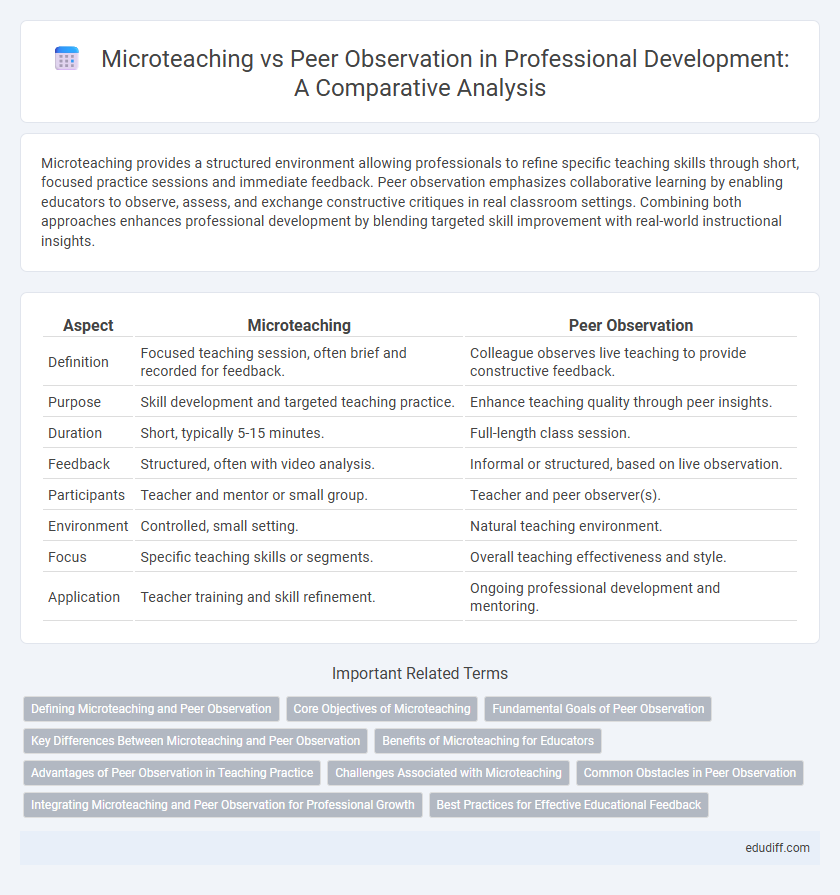Microteaching provides a structured environment allowing professionals to refine specific teaching skills through short, focused practice sessions and immediate feedback. Peer observation emphasizes collaborative learning by enabling educators to observe, assess, and exchange constructive critiques in real classroom settings. Combining both approaches enhances professional development by blending targeted skill improvement with real-world instructional insights.
Table of Comparison
| Aspect | Microteaching | Peer Observation |
|---|---|---|
| Definition | Focused teaching session, often brief and recorded for feedback. | Colleague observes live teaching to provide constructive feedback. |
| Purpose | Skill development and targeted teaching practice. | Enhance teaching quality through peer insights. |
| Duration | Short, typically 5-15 minutes. | Full-length class session. |
| Feedback | Structured, often with video analysis. | Informal or structured, based on live observation. |
| Participants | Teacher and mentor or small group. | Teacher and peer observer(s). |
| Environment | Controlled, small setting. | Natural teaching environment. |
| Focus | Specific teaching skills or segments. | Overall teaching effectiveness and style. |
| Application | Teacher training and skill refinement. | Ongoing professional development and mentoring. |
Defining Microteaching and Peer Observation
Microteaching is a scaled-down teaching session designed for focused skill development, allowing educators to practice and refine specific instructional techniques in a controlled environment. Peer observation involves educators observing each other's teaching practices in real-time to provide constructive feedback and foster collaborative professional growth. Both methods aim to enhance teaching effectiveness but differ in structure, with microteaching focusing on isolated skills and peer observation on holistic classroom dynamics.
Core Objectives of Microteaching
Microteaching focuses on developing specific teaching skills through controlled, short teaching sessions aimed at improving instructional techniques and building confidence in educators. It emphasizes skill acquisition, self-reflection, and targeted feedback to refine pedagogical methods effectively. Peer observation, while valuable for collaborative learning and broader classroom insights, does not concentrate as intensively on the micro-level teaching skill enhancement central to microteaching.
Fundamental Goals of Peer Observation
Peer observation aims to enhance teaching quality through collaborative feedback, fostering reflective practice and continuous professional development among educators. It supports identifying strengths and areas for improvement by promoting open dialogue and shared experiences in real classroom settings. This method encourages a culture of mutual support, accountability, and ongoing learning within academic institutions.
Key Differences Between Microteaching and Peer Observation
Microteaching involves a controlled, short teaching session aimed at improving specific teaching skills through self-assessment and feedback from a limited audience, while peer observation entails real-time evaluation of actual classroom teaching by colleagues to promote reflective practice and professional development. Microteaching typically uses simulated lessons with a focus on mastering particular techniques, whereas peer observation assesses broader instructional methods and classroom management in authentic teaching environments. The key difference lies in the context and scope--microteaching is skill-specific and condensed, whereas peer observation is comprehensive and integrated into daily teaching practice.
Benefits of Microteaching for Educators
Microteaching enhances educators' instructional skills through focused practice and immediate feedback, fostering rapid improvement in teaching techniques. This method allows for targeted development of specific competencies, resulting in increased confidence and classroom effectiveness. Structured sessions also promote self-reflection and adaptability, essential for continuous professional growth.
Advantages of Peer Observation in Teaching Practice
Peer observation enhances reflective teaching practices by enabling educators to receive constructive feedback from colleagues with similar expertise. It fosters collaborative professional development, promotes the exchange of innovative instructional strategies, and supports continuous improvement through real-time classroom insights. This practice creates a supportive learning community that encourages shared accountability and mutual growth among educators.
Challenges Associated with Microteaching
Microteaching presents challenges such as limited real-world classroom dynamics, as sessions involve a small group or a single peer observer rather than a full class setting. Instructors may experience performance anxiety due to the intensified scrutiny in a controlled environment, which can hinder authentic teaching behavior. Furthermore, the artificial setting can restrict the development of classroom management skills and reduce opportunities for spontaneous interaction and feedback.
Common Obstacles in Peer Observation
Common obstacles in peer observation include observer bias, lack of standardized criteria, and discomfort among peers, which can hinder objective feedback and professional growth. Time constraints and scheduling conflicts often limit opportunities for meaningful observations and follow-up discussions. Overcoming resistance to critique requires establishing trust and a culture of constructive feedback in educational or organizational settings.
Integrating Microteaching and Peer Observation for Professional Growth
Integrating microteaching and peer observation enhances professional growth by combining targeted skill development with real-time feedback, fostering reflective practice and self-improvement. Microteaching allows educators to practice specific teaching techniques in a controlled environment, while peer observation provides diverse perspectives and constructive critique during actual classroom interactions. Together, these methods create a comprehensive framework for continuous learning, promoting effective teaching strategies and collaborative professional development.
Best Practices for Effective Educational Feedback
Microteaching and peer observation are essential methods for delivering effective educational feedback, emphasizing specificity, timeliness, and constructive criticism. Best practices involve setting clear objectives, using descriptive rather than evaluative language, and fostering a supportive environment that encourages reflective dialogue. Incorporating video recordings and structured feedback forms enhances accuracy and helps educators identify actionable improvements.
Microteaching vs Peer Observation Infographic

 edudiff.com
edudiff.com